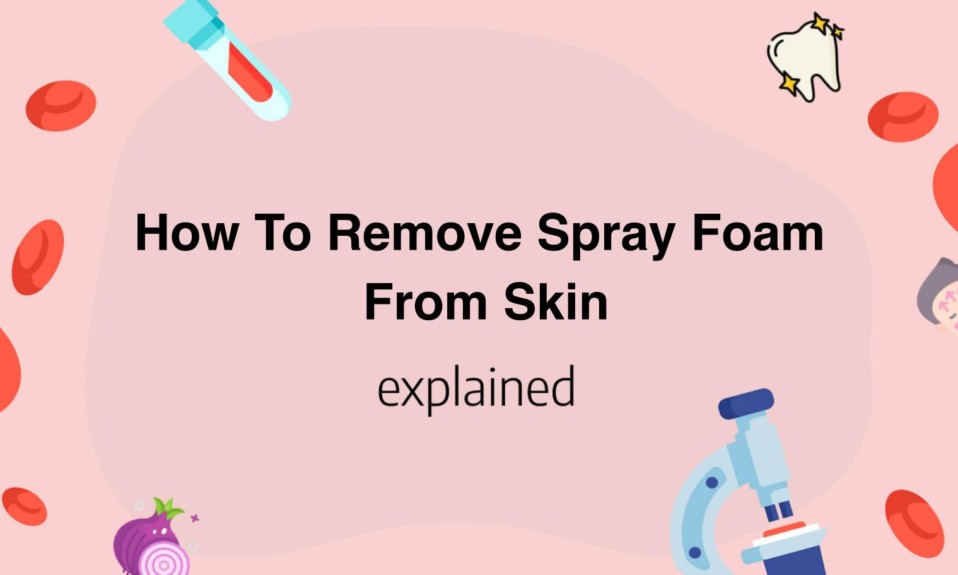If you’ve accidentally gotten spray foam on your skin, you may find that it’s difficult to remove.
Fortunately, there are several tried-and-true methods you can use to get it off.
Whether you’re dealing with polyurethane or silicone-based foam, the right techniques can help you avoid skin irritation and long-term damage.
In this article, we’ll explore some effective ways to get rid of spray foam from your skin safely and efficiently.
- Apply a generous amount of petroleum jelly or baby oil to the affected area.
- Allow the oil to sit on the skin for several minutes.
- Rub the affected area with a cloth or paper towel to loosen the foam.
- Rinse the area with warm, soapy water and dry gently.
- Repeat as necessary until all foam residue is removed from the skin.
How To Remove Spray Foam From Skin
To remove spray foam from skin, you must act fast and follow the proper steps.
First of all, do not panic, as it can worsen the situation.
The spray foam hardens quickly, so it is essential to remove it as soon as possible.
The following steps will guide you on how to remove the spray foam from the skin safely and effectively:
- Step 1: Use a blunt object like a spoon or a spatula to remove the dried foam gently.
Be careful not to scrape your skin.
- Step 2: Apply petroleum jelly on the spray foam if it is not already dried.
Leave it on for a few minutes to help soften the foam.
- Step 3: Use a scrub brush with soft bristles to scrub away the foam gently.
Do not use a wire brush or other abrasive tools that can damage your skin.
Rinse the affected area with warm water and soap.
- Step 4: If the spray foam has already hardened, use an acetone-based nail polish remover to remove it.
Soak a cotton ball in the nail polish remover and dab it onto the affected area.
Leave it for a few minutes to dissolve the foam before wiping it away.
- Step 5: After removing the foam, apply antibacterial ointment on the affected area to prevent infections.
Cover the wound with a sterile bandage if necessary.
It is crucial to take precautions when using spray foam, such as wearing protective clothing and gloves to prevent skin contact.
If you accidentally get spray foam on your skin, follow the steps above to remove it safely.
In summary, removing spray foam from skin requires patience and care.
Act quickly, use gentle tools and materials such as petroleum jelly, scrub brush, and nail polish remover, and apply antibacterial ointment to the affected area once you are done.
By following these steps, you can safely remove spray foam and avoid skin problems.
Ways to remove spray foam from skin
Spray foam insulation is a highly effective way to seal cracks and insulate homes, but if it gets on your skin, it can be difficult to remove.
The key to removing spray foam from skin is to act quickly before it hardens.
Here are some ways to remove spray foam from skin:
- Use acetone: One of the most effective ways to remove spray foam from skin is to use acetone.
Simply apply a small amount of acetone to a cotton pad or cloth and gently rub the affected area until the foam dissolves.
- Use soap and water: If you don’t have acetone, soap and water can also work.
Wet the affected area with warm soapy water and gently rub until the foam dissolves.
- Use petroleum jelly: If the foam has already hardened, you can still remove it with petroleum jelly.
Apply a generous amount on the affected area and rub gently until the foam starts to dissolve.
- Seek professional help: If the spray foam gets in your eyes or mouth, seek professional medical help immediately.
Do not attempt to remove it yourself.
Rinse with plenty of water.
Then wash with soap and water.
Remember, prevention is key.
To avoid getting spray foam on your skin, wear protective clothing such as gloves and long-sleeved shirts.
Also, make sure to read the manufacturer’s instructions carefully before using the spray foam.
In conclusion, removing spray foam from skin can be a daunting task, but with these tips, you can easily remove it from your skin.
You can use acetone or soap and water to remove it quickly, or petroleum jelly to remove hardened foam.
And always remember to seek professional help if it gets in your eyes or mouth.

Precautions to take when removing spray foam
When removing spray foam, there are a few precautions that everyone should take to ensure that the process is done safely and properly.
First and foremost, it is important to wear protective clothing and gear to prevent any contact with the foam.
This includes gloves, a mask, goggles, and a long-sleeved shirt and pants.
Not only can the foam be difficult and messy to remove, but it can also release harmful chemicals.
Additionally, it is important to properly prepare the area before starting the removal process.
Remove any furniture or items in the immediate area and cover any remaining items thoroughly.
This will prevent any damage or contamination.
It is also crucial to properly ventilate the area by opening windows and using fans to help remove any lingering vapors.
When removing the foam, it is best to use a combination of scraping and sanding to remove as much of the foam as possible.
Only use solvents as a last resort, as they can be dangerous and release harmful fumes.
It is also important to properly dispose of any waste material, as it can be considered hazardous.
Contact your local waste management facility for guidance on disposal methods.
Finally, it is recommended to hire a professional to remove the foam if you are not properly trained or equipped to do so.
A professional will have the proper tools and equipment to ensure that the job is done safely and efficiently.
They will also be able to properly dispose of any waste material and minimize any potential hazards.
By taking these precautions, you can ensure that the removal process is done safely and effectively.
Don’t take any chances with your health and always prioritize safety when working with potentially hazardous materials.
The dangers of leaving spray foam on skin
Spray foam insulation is a popular choice for homeowners looking to reduce energy costs.
However, the danger lies in its chemical composition, which can lead to skin irritation and even chemical burns.
When spray foam comes into contact with skin, it can cause redness, swelling, and itching.
If the exposure is prolonged, the foam can cause chemical burns that leave permanent scars.
An important factor to note is that the effects of spray foam on the skin depend on the type and concentration of chemicals used in the foam.
When spray foam is applied, it should only be in areas that are out of reach or in closed spaces.
Protective gear, like gloves and goggles, should be worn at all times.
If the foam accidentally gets on skin, it should be immediately washed off with soap and water or a safe chemical solvent.
Moreover, it is essential not to scratch or pick at the affected area, which increases the risk of infection.
It’s crucial to be aware of the symptoms that arise from contact with spray foam, which often occur within the first hour of exposure.
The affected area may become red, swollen, and itchy, leading to a desire to scratch.
In severe cases, blisters, chemical burns, and infection may develop.
If any of these symptoms occur, seek medical attention immediately.
In conclusion, spray foam is an innovative insulation option but requires careful handling to prevent skin damage.
Protective wear is a must, and any accidental contact with skin should be addressed with urgency.
It can be tempting to overlook these precautions in the interest of convenience, but the consequences are not worth the risk.
By taking these necessary measures, homeowners and workers alike can use spray foam without compromising their safety.
You’ll also like: Water Sound In Belly During Pregnancy
Best products to use for removing spray foam
When it comes to removing spray foam, there are a few products that can help get the job done.
One of the most effective options is acetone.
Acetone works by dissolving the foam, making it easy to wipe away.
However, it’s important to use caution when working with acetone, as it is highly flammable and can be dangerous if not handled properly.
For this reason, it’s best to wear protective gloves and work in a well-ventilated area.
Another option for removing spray foam is isopropyl alcohol.
This product is less harsh than acetone and is a good option for those who are looking for a less toxic solution.
Isopropyl alcohol works by softening the foam, making it easier to scrape away with a plastic scraper.
It’s important to note that isopropyl alcohol may not be as effective as acetone at removing larger amounts of foam.
For those who are looking for a more natural solution, citrus-based cleaners can also be effective at removing spray foam.
These cleaners work by breaking down the foam and making it easier to wipe away.
One popular option is orange oil, which is known for its natural cleaning properties.
Simply apply the cleaner to the affected area and wipe away with a cloth.
In addition to these products, there are also specialized foam removers available on the market.
These products are designed specifically for removing spray foam and may be more effective than general-purpose cleaners.
However, they can also be more expensive.
Overall, there are a variety of options available for removing spray foam.
When choosing a product, it’s important to consider factors such as effectiveness, safety, and cost.
By weighing these factors and selecting the best product for your needs, you can effectively remove spray foam from a variety of surfaces.
You’ll also like: Why Is My Pregnant Belly Soft When I Lay Down
Why it’s important to remove spray foam from skin ASAP
Spray foam insulation has become quite popular over the past few years, and it’s easy to see why.
It’s cost-effective, easy to install, and helps to reduce energy costs.
However, it’s important to note that this material can be dangerous if not handled properly.
In particular, if spray foam comes into contact with your skin, you need to take action immediately.
First of all, spray foam is toxic to humans, so you don’t want to leave it on your skin for too long.
The chemicals that make up spray foam can cause skin irritation, respiratory problems, and even more serious health issues.
If you leave the foam on your skin for too long, you may experience symptoms such as dizziness, shortness of breath, and skin rashes.
Secondly, spray foam is difficult to remove once it has set.
The foam is designed to adhere to surfaces and expand, creating a tight seal.
This is great for insulation purposes, but not so great for your skin.
If you don’t act quickly to remove the foam, it can become hardened and almost impossible to get off.
So, why is it important to remove spray foam from your skin as soon as possible? For one thing, early removal reduces the amount of exposure to the toxic chemicals in the foam.
The longer the foam stays on your skin, the more time those chemicals have to seep into your system.
By removing the foam quickly, you can minimize your exposure and reduce your risk of health problems.
Another reason to act quickly is that it’s much easier to remove the foam while it’s still wet.
Once the foam has hardened, you may need to resort to more drastic measures to get it off.
For example, you may need to use harsh chemicals or even sandpaper to remove the foam.
By removing the foam while it’s still wet, you can avoid the hassle and potential damage to your skin.
In conclusion, if you come into contact with spray foam insulation, take action immediately.
Remove the foam from your skin as soon as possible to reduce your risk of health problems and make the removal process as easy as possible.
If you experience any symptoms of exposure, such as skin irritation or respiratory problems, seek medical attention right away.
And always remember to handle spray foam with care to minimize your risk of exposure in the first place.
You’ll also like:










